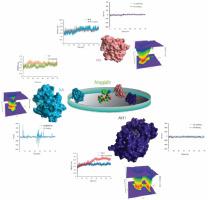Computer Methods and Programs in Biomedicine ( IF 4.9 ) Pub Date : 2020-07-14 , DOI: 10.1016/j.cmpb.2020.105660 Khattab Al-Khafaji 1 , Tugba Taskin Tok 2

|
Background and objective
Historically, amygdalin has been used as alternative medicine or in vitro and in vivo studies, but no single study exists which discusses the structural mechanism of amygdalin at a molecular level. This paper inquiries into the inhibitory actions of amygdalin on the selected targets: AKT1, FAK, and ILK, which are regulators for various mediated signaling pathways, and are associated with cell adhesion, migration, and differentiation. In order to get details at the molecular level of amygdalin's inhibitory activities against chosen proteins, molecular modeling and simulation techniques including double docking, molecular dynamics simulation, free energy landscape analysis, and binding free energy calculation were exerted.
Methods
To get molecular level details of amygdalin inhibitory effects against the relevant proteins; here the utilized tools are the following: the double docking, molecular dynamics simulation, free energy landscape analysis, g_mmpbsa, and interaction entropy were used to evaluate the inhibitory activity against targeted proteins.
Results
The computational calculations revealed that amygdalin inhibits the selected targets via block the ATP-binding pocket of AKT1, FAK, and ILK by forming stable hydrogen bonds. Moreover, free energy landscape, FEL exposed that amygdalin stabilized the global conformations of both FAK and ILK proteins to the minimum global energy besides it reduced the essential dynamics of FAK and ILK proteins. MMPBSA computations provided further evidence for amygdalin's stability inside the ATP-binding pocket of AKT1, FAK, and ILK with a binding free energy of 45.067, −13.033, 13.109 kJ/mol, respectively. The binding free energies are lastly consistent with the hydrogen bonding and pairs within 0.35 nm results. The decomposition of binding energy shows the pivotal amino acid residues responsible for the stability of amygdalin's interactions inside the ATP-binding sites by forming hydrogen bonds.
Conclusions
Before this work, it was enigmatic to make predictions about how amygdalin inhibits metastasis of cancer. But the computational results contribute in several ways to our understanding of amygdalin activity and provide a basic insight into the activity of amygdalin as a multi-target drug in the metastasis and invasion of cancer.
中文翻译:

分子动力学模拟,自由能态势和结合自由能计算,用于探索苦杏仁苷对转移的抗侵袭活性。
背景和目标
历史上,苦杏仁苷已被用作替代药物或用于体外和体内研究,但尚无单个研究在分子水平上探讨苦杏仁苷的结构机理。本文探讨了苦杏仁苷对所选靶标的抑制作用:AKT1,FAK和ILK,它们是各种介导信号通路的调节剂,并与细胞粘附,迁移和分化有关。为了在苦杏仁苷对所选蛋白质的抑制活性的分子水平上获得详细信息,采用了分子建模和模拟技术,包括双对接,分子动力学模拟,自由能态分析和结合自由能计算。
方法
获得苦杏仁苷对相关蛋白质的抑制作用的分子水平细节;这里使用的工具如下:使用双对接,分子动力学模拟,自由能态分析,g_mmpbsa和相互作用熵来评估对靶蛋白的抑制活性。
结果
计算结果表明,苦杏仁苷通过形成稳定的氢键来阻断AKT1,FAK和ILK的ATP结合口袋,从而抑制了选定的靶标。此外,在自由能领域,FEL暴露了苦杏仁苷将FAK和ILK蛋白的全局构象稳定在最小的全局能量上,此外它还降低了FAK和ILK蛋白的基本动力学。MMPBSA计算进一步提供了苦杏仁苷在AKT1,FAK和ILK的ATP结合口袋内的稳定性的进一步证据,结合自由能分别为45.067,-13.033、13.109 kJ / mol。结合自由能最后与氢键一致,结果在0.35 nm以内。结合能的分解显示出负责苦杏仁苷'稳定性的关键氨基酸残基
结论
在进行这项工作之前,对苦杏仁苷如何抑制癌症转移进行预测是个谜。但是计算结果以多种方式有助于我们对苦杏仁苷活性的理解,并提供了对苦杏仁苷作为癌症转移和侵袭中多靶标药物活性的基本认识。











































 京公网安备 11010802027423号
京公网安备 11010802027423号